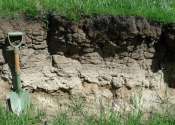Scientists construct organo-phosphatic shells of brachiopods
Biomineralized columns, stacked in layers like a sandwich gave Cambrian brachiopod shells their strength and flexibility 520 million years ago.

Biomineralized columns, stacked in layers like a sandwich gave Cambrian brachiopod shells their strength and flexibility 520 million years ago.
Evolution
Apr 18, 2024
0
33

Even intense exercise by astronauts cannot compensate for muscle atrophy caused by microgravity. Atrophy occurs, in part, by way of an underlying mechanism that regulates calcium uptake. Recent research has shown exposure ...
Space Exploration
Apr 17, 2024
0
8

Soil carbon usually refers only to the organic matter component of soils, known as soil organic carbon (SOC). However, soil carbon also has an inorganic component, known as soil inorganic carbon (SIC). Solid SIC, often calcium ...
Earth Sciences
Apr 11, 2024
0
211

As a scientist, lab work can sometimes get monotonous. But in 2017, while a Ph.D. student of paleobiology at the University of Bristol in the U.K., I heard a gleeful exclamation from across the room. Kirsty Penkman, head ...
Paleontology & Fossils
Apr 10, 2024
0
965

A new study has shown pollen grains can be used as green templates for producing biomaterials, showcasing their potential to support drug delivery and bone regeneration.
Biotechnology
Apr 3, 2024
0
119

Lysosomes, often reductively referred to as the "garbage disposals" of cells, play a pivotal role in our cells' digestive systems by getting rid of unwanted materials.
Cell & Microbiology
Apr 1, 2024
0
9

Exactly how does coral make its skeleton, a sea urchin grow a spine, or an abalone form the mother-of-pearl in its shell? A new study at the Advanced Light Source at the Department of Energy's Lawrence Berkeley National Laboratory ...
Bio & Medicine
Mar 26, 2024
0
26

Adding too much water to your plants can damage them as much as not having enough water. In the environment, plants submerged under excessive rain have limited access to light and oxygen, which reduces or eliminates their ...
Biotechnology
Mar 13, 2024
1
31

For many hundreds of millions of years, the average temperature at the surface of the Earth has varied by not much more than 20° Celsius, facilitating life on our planet. To maintain such stable temperatures, Earth must ...
Earth Sciences
Mar 7, 2024
0
231

Autophagy is a self-eating process for recycling and rejuvenating cellular organelles and components. Intracellular calcium dynamics has been shown to be essential for the initiation of the autophagy process.
Cell & Microbiology
Mar 6, 2024
0
10
Calcium (pronounced /ˈkælsiəm/) is the chemical element with the symbol Ca and atomic number 20. It has an atomic mass of 40.078 amu. Calcium is a soft grey alkaline earth metal, and is the fifth most abundant element by mass in the Earth's crust. Calcium is also the fifth most abundant dissolved ion in seawater by both molarity and mass, after sodium, chloride, magnesium, and sulfate.
Calcium is essential for living organisms, particularly in cell physiology, where movement of the calcium ion Ca2+ into and out of the cytoplasm functions as a signal for many cellular processes. As a major material used in mineralization of bones and shells, calcium is the most abundant metal by mass in many animals.
This text uses material from Wikipedia, licensed under CC BY-SA